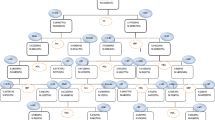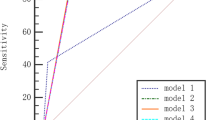Abstract
Aim: The purpose of this study was to explore the difference in the pattern of metabolic syndrome (MetS) in urban and rural populations in Korea using data mining techniques. Subjects and methods: In total, 1013 adults >30 yr of age from urban (184 males and 313 females) and rural districts (211 males and 305 females) were recruited from Gyeongsangnam-do, Korea. Modified National Cholesterol Education Program Adult Treatment Panel III criteria were used to identify individuals with MetS. We applied a decision tree analysis to elucidate the differences in the clustering of MetS components between the urban and rural populations. Results: The prevalence of MetS was 33.2% and 35.2% in urban and rural districts, respectively (p=0.598). The decision-tree approach revealed that the combination of high serum triglycerides (TG) + high systolic blood pressure (SBP), high TG + low HDL cholesterol, and high waist circumference (WC) + high SBP + high fasting plasma glucose (FPG) were strong predictors of MetS in the urban population, whereas the combination of TG + SBP + WC and SBP + WC + FPG showed high positive predictive value for the presence of MetS in the rural population. Conclusions: Although no significant difference was found for the prevalence of MetS between the two populations, the differences in the clustering pattern of MetS components in urban and rural districts in Korea were identified by decision tree analysis. Our findings may serve as a basis to design necessary population-based intervention programs for prevention and progression of MetS and its complications in Korea.
Similar content being viewed by others
References
Meigs JB. Invited commentary: insulin resistance syndrome? Syndrome X? Multiple metabolic syndrome? A syndrome at all? Factor analysis reveals patterns in the fabric of correlated metabolic risk factors. Am J Epidemiol 2000, 152: 908–11; discussion 12.
Grundy SM. Metabolic syndrome pandemic. Arterioscler Thromb Vasc Biol 2008, 28: 629–36.
Wang JJ, Qiao Q, Miettinen ME, Lappalainen J, Hu G, Tuomilehto J. The metabolic syndrome defined by factor analysis and incident type 2 diabetes in a chinese population with high postprandial glucose. Diabetes Care 2004, 27: 2429–37.
Hu G, Qiao Q, Tuomilehto J, Balkau B, Borch-Johnsen K, Pyorala K; DECODE Study Group. Prevalence of the metabolic syndrome and its relation to all-cause and cardiovascular mortality in nondiabetic European men and women. Arch Intern Med 2004, 164: 1066–76.
Araneta MR, Wingard DL, Barrett-Connor E. Type 2 diabetes and metabolic syndrome in Filipina-American women: a high-risk non-obese population. Diabetes Care 2002, 25: 494–9.
Tan DA. Changing disease trends in the Asia-Pacific. Climacteric 2011, 14: 529–34.
Heber D. An integrative view of obesity. Am J Clin Nutr 2010, 91: 280S–3S.
Lim S, Shin H, Song J, et al. Increasing prevalence of metabolic syndrome in Korea: the Korean National Health and Nutrition Examination Survey for 1998–2007. Diabetes Care 2011, 34: 1323–8.
Mahadik SR, Deo SS, Mehtalia SD. Increased prevalence of metabolic syndrome in non-obese asian Indian-an urban-rural comparison. Metab Syndr Relat Disord 2007, 5: 142–52.
Lim S, Jang HC, Lee HK, Kimm KC, Park C, Cho NH. A rural-urban comparison of the characteristics of the metabolic syndrome by gender in Korea: the Korean Health and Genome Study (KHGS). J Endocrinol Invest 2006, 29: 313–9.
Weng X, Liu Y, Ma J, Wang W, Yang G, Caballero B. An urban-rural comparison of the prevalence of the metabolic syndrome in Eastern China. Public Health Nutr 2007, 10: 131–6.
Quentin-Trautvetter J, Devos P, Duhamel A, Beuscart R; Qualidiab Group. Assessing association rules and decision trees on analysis of diabetes data from the DiabCare program in France. Stud Health Technol Inform 2002, 90: 557–61.
Firouzi F, Rashidi M, Hashemi S, et al. A decision tree-based approach for determining low bone mineral density in inflammatory bowel disease using WEKA software. Eur J Gastroenterol Hepatol 2007, 19: 1075–81.
Szabo de Edelenyi F, Goumidi L, Bertrais S, et al. Prediction of the metabolic syndrome status based on dietary and genetic parameters, using Random Forest. Genes Nutr 2008, 3: 173–6.
Worachartcheewan A, Nantasenamat C, Isarankura-Na-Ayudhya C, Pidetcha P, Prachayasittikul V. Identification of metabolic syndrome using decision tree analysis. Diabetes Res Clin Pract 2010, 90: e15–8.
American Heart Association; National Heart, Lung, and Blood Institue, Grundy SM, Cleeman JI, Daniels SR, et al. Diagnosis and management of the metabolic syndrome. An American Heart Association/National Heart, Lung, and Blood Institute Scientific Statement. Executive summary. Cardiol Rev 2005, 13: 322–7.
Yang SH, Dou KF, Song WJ. Prevalence of diabetes among men and women in China. N Engl J Med 2010, 362: 2425–6.
Prabhakaran D, Chaturvedi V, Shah P, et al. Differences in the prevalence of metabolic syndrome in urban and rural India: a problem of urbanization. Chronic Illn 2007, 3: 8–19.
Abdul-Rahim HF, Husseini A, Bjertness E, Giacaman R, Gordon NH, Jervell J. The metabolic syndrome in the West Bank population: an urban-rural comparison. Diabetes Care 2001, 24: 275–9.
Martínez-Larrad MT, Fernández-Pérez C, González-Sánchez JL, et al; Grupo de Estudio de Atención Primaria de Segovia. Prevalence of the metabolic syndrome (ATP-III criteria). Population-based study of rural and urban areas in the Spanish province of Segovia. Med Clin (Barc) 2005, 125: 481–6.
Statistics Korea. Census [Internet], 2010. Daejeon, South Korea, Korean statistical Information service. Available at http://kosis.kr/index/index.jsp. Accessed October 12, 2010.
Lemieux I, Poirier P, Bergeron J, et al. Hypertriglyceridemic waist: a useful screening phenotype in preventive cardiology? Can J Cardiol 2007, 23(Suppl B): 23B–31B.
Author information
Authors and Affiliations
Corresponding author
Rights and permissions
About this article
Cite this article
Kim, T.N., Kim, J.M., Won, J.C. et al. A decision tree-based approach for identifying urban-rural differences in metabolic syndrome risk factors in the adult Korean population. J Endocrinol Invest 35, 847–852 (2012). https://doi.org/10.3275/8235
Accepted:
Published:
Issue Date:
DOI: https://doi.org/10.3275/8235




